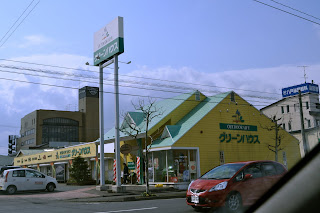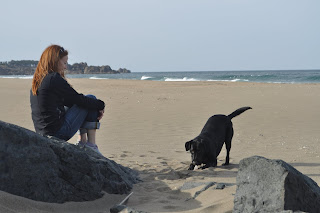We went on short tours of Misawa and Hachinohe as part of our introduction to living here. We visited a Buddhist temple, a samurai museum, a fish market, a train station and a Shinto shrine.
This is the Buddhist temple we visited. Most Japanese follow a hybrid of Buddhist and Shinto religions. I can't tell you much about either religion, but it's impressive to tour the very elaborate temples and shrines.
Outside the temple was a graveyard. This very elaborate stone (it's probably 12 foot high) is a family "plot". All the members of a family are placed here after they die and are cremated. We were told that one of these plots is extremely expensive - the equivalent of about $150,000.
This is a Samurai house museum in Misawa.
Inside the Samurai house - Things here just weren't meant for taller, or even averaged-sized Americans.
Hachinohe is about 45 minutes from Misawa and has the coolest fish market ever. We were told that the fish was as fresh as it could get (being located minutes from the Pacific has it's advantages), but what we didn't realize was a lot of the seafood was still alive! The clams spit at us as we walked by, the crabs waved their pinchers, some of the fish were still swimming around in styrofoam coolers!
This little boy was dancing all over the place.
Most of the vendors had samples out. This sample was teriyaki squid. We tried it. We also tried seaweed, and octopus, and a variety of other things that I really couldn't identify.
Boiled octopus samples. It was very chewy and very salty.
During lunchtime, they open up these tables and put hot coals into the center fire pits of each table. You can buy your very fresh seafood and cook it right there at the market. We're planning on returning there someday during lunch to check it out.
Our last stop in Hachinohe - the Kushihiki Hachiman Shrine. This is the torii gate indicating the entrance to the shrine. The white zigzag papers hanging on the rope ward off bad spirits.
Before you enter the shrine you must purify your hands and mouth. This water fountain has several ladles so that visitors can rinse their hands and mouths properly before passing through the torii gate.
After purifying your hands and mouth, and passing through the gate, you approach the shrine where you pray. There is a very specific way to pray. First bow, then toss your coins in the offering, then ring the bell to let the gods know you're there, then bow deeply twice, then clap twice, then bow again... something like that. I can never remember the order.
This is Chris and our amazing Japanese tour guide who explained everything to us.
This is where prayers are written on wooden tablets and hung to be answered I suppose. Our guide was reading some of them to us... prayers for luck on entrance exams, prayers for luck getting into college, etc. Some things never change, no matter what culture you're in:-)
Here you can buy your fortune for 100 yen (about $1). If it's not good, you can hang it from one of these strings and maybe it'll turn out okay anyway.













































